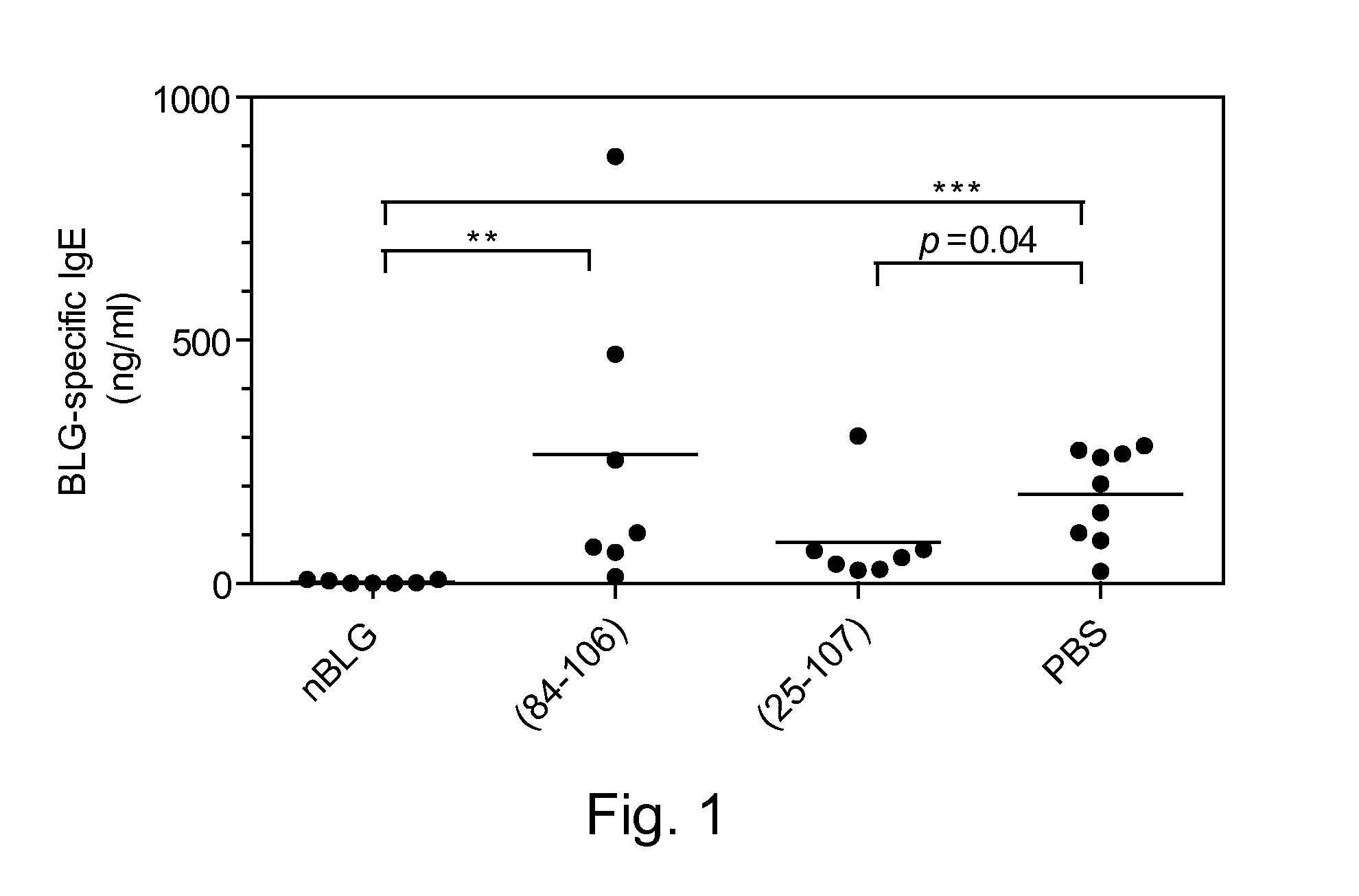Newly identified peptides for use in the induction of oral tolerance in young mammals
a technology of peptides and peptides, which is applied in the field of newly identified peptides of lactoglobulin, can solve the problems of failure to establish oral tolerance, formulations exhibiting the highest degree of non-allergenicity, and formulations that are unsuitable for inducing cow's milk protein tolerance, etc., and achieves the effect of facilitating recognition
- Summary
- Abstract
- Description
- Claims
- Application Information
AI Technical Summary
Benefits of technology
Problems solved by technology
Method used
Image
Examples
example 1
Isolation and Identification of Peptides Capable of Inducing Oral Tolerance to BLG
[0111]Cell Culture
[0112]To assess MHC receptor expression on two different human monocytic cells (U937 and Thp1), cells were stained with APC conjugated anti HLA-DR (Santa Cruz Biotechnologies, clone L243) for 30 min on ice, washed twice with cold PBS 1× (Sigma) supplemented with 0.5% of FCS (Amimed, Bioconcept), then analyzed on a flow analyzer BD Fortessa (BD).
[0113]To assess the toxicity of BEBA-HA infant formula on U937 and Thp1 cell lines, cells were incubated with various concentrations of BEBA-HA product ranging from 10 mg to 1 ng reconstituted in complete RPMI1640 medium. Cells were incubated at a concentration of 1×106 cells / mL in 24 well plates for 24 h at 37° C. in presence of 5% CO2. Cells were spun down and washed twice with PBS 1× supplemented with 0.5% of FCS, then stained with PE Annexin V Apoptosis Detection Kit I (BD Pharmingen). Finally, cells were analyzed by flow cytometry on a BD ...
example 2
BLG-specific Humoral Immune Responses in Mice Gavaged with nBLG or Synthetic Peptides and then Experimentally Sensitized
[0119]Mice
[0120]Specific pathogen-free (SPF) BALB / cJ mice (3 to 4 weeks-old females, Centre d'Elevage René Janvier, Le Genest Saint-Isle, France) were housed in filtered cages under normal SPF husbandry conditions (autoclaved bedding and sterile water) and were acclimatized for two weeks before experiments. They were maintained on a diet deprived of animal protein, and in which BLG was not detected using specific sandwich immunoassays. All animal experiments were performed according to European Community rules of animal care, and with authorization 91-368 of the French Veterinary Services. All experiments were covered by agreement No. 2009-DDSV-074 (Oct. 29, 2009) from the Veterinary Inspection Department of Essonne (France).
[0121]Effect of BLG and Synthetic Peptide Administration
[0122]Groups of 6 or 7 mice were administered either 4 mg of native bovine BLG, or equ...
example 3
[0127]An example of the composition of an infant formula for use according to the present invention is given below. This composition is given by way of illustration only.
NutrientPer 100 kcalPer litreEnergy100670Partially Hydrolyzed1.8312.3Protein including peptides1-5Fat5.335.7Linoleic acid (g)0.795.3α-Linolenic acid (mg)101675Lactose (g)11.274.7Prebiotic (100% GOS) (g)0.644.3Minerals (g)0.372.5Na (mg)23150K (mg)89590Cl (mg)64430Ca (mg)62410P (mg)31210Mg (mg)750Mn (μg)850Se (μg)213Vitamin A (μg RE)105700Vitamin D (μg)1.510Vitamin E (mg TE)0.85.4Vitamin K1 (μg)854Vitamin C (mg)1067Vitamin B1 (mg)0.070.47Vitamin B2 (mg)0.151.0Niacin (mg)16.7Vitamin B6 (mg)0.0750.50Folic acid (μg)960Pantothenic acid (mg)0.453Vitamin B12 (μg)0.32Biotin (μg)2.215Choline (mg)1067Fe (mg)1.28I (μg)15100Cu (mg)0.060.4Zn (mg)0.755Lactobacillus GG2 × 107 cfu / g of powder
PUM
| Property | Measurement | Unit |
|---|---|---|
| molecular weight | aaaaa | aaaaa |
| temperature | aaaaa | aaaaa |
| temperature | aaaaa | aaaaa |
Abstract
Description
Claims
Application Information
 Login to View More
Login to View More - R&D
- Intellectual Property
- Life Sciences
- Materials
- Tech Scout
- Unparalleled Data Quality
- Higher Quality Content
- 60% Fewer Hallucinations
Browse by: Latest US Patents, China's latest patents, Technical Efficacy Thesaurus, Application Domain, Technology Topic, Popular Technical Reports.
© 2025 PatSnap. All rights reserved.Legal|Privacy policy|Modern Slavery Act Transparency Statement|Sitemap|About US| Contact US: help@patsnap.com

